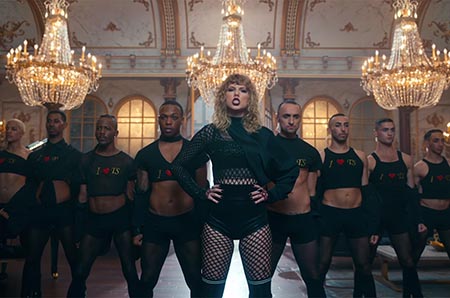
After enjoying the long success of 1989 back in 2014, Taylor Swift has returned to the music scene with her new hit “Look What You Made Me Do,” a single off her new album Reputation, which is set to release in November.
Taylor Swift, as many who follow pop culture know, has certainly built a “reputation,” or rather, a calculated presence that has made her the center of media coverage since her breakthrough in 2008. And while many fans are excited to have her back, as evidence by the number of streams and hits the new single has accumulated so far, there is no denying that Swift’s return is being examined and scrutinized more than ever.
Once Swift was back on social media after a few months on hiatus, which was a headline in itself, she released a photo from her new music video, “Look What You Made Me Do.” The still, showing Swift in the center of her background dancers, dressed in fishnets and black attire, immediately became an internet joke, since it seemed to resemble Beyonce’s “Formation,” a song celebrating black women and culture. Though the director of the video has denied those claims, Swift has been in trouble before for cultural appropriation and “playing the victim” in an endless vacuum of feuds.
Three years ago, Swift released the video for “Shake it Off.” In the video, Swift took on different roles. In one scene, she is dressed in a leopard bomber and large hoop earrings, accompanied by predominantly black dancers and later, she attempts to twerk. This use of black culture as something funny and lighthearted was criticized by many people of color.
“I think it’s important to note that there is nothing original about what [artists like Katy Perry and Miley Cyrus] are doing. Madonna did this years ago when she vogued in her video. Vogue was a style of dance created by Black and Latino gay men and trans women,” explained Nicole Carr, professor of Black Studies at SUNY New Paltz. “[They] are all carrying on in the white supremacist tradition of stealing from black culture to make themselves appear ‘cool,’ ‘hip,’ etc.”
While “Shake it Off” was mainly Swift’s ploy to brush off her past conflicts with other celebrities such as Kanye West and Katy Perry, she couldn’t help but rehash old feuds by coming out with “Bad Blood,” a single that she claimed was not about a romantic relationship but about a woman within the entertainment industry who tried to sabotage her. Inevitably, fans and media concluded it was about Katy Perry, since it was rumoured that Perry stole Swift’s backup dancers. This was perfect timing. Fans bought into the feud and story, making Swift’s single the diss track of the summer.
In the detailed Buzzfeed article “How Taylor Swift Played the Victim for a Decade and Made Her Entire Career,” Ellie Woodward explains how even though Swift has proclaimed herself as a “feminist,” she simply remained silent and continued to extend or drag along her feuds with other female celebrities in the midst of the presidential election and Trump’s overt misogynistic comments. Woodward argued that Swift’s scandals continued her prominence within media outlets, as they were designed to make herself the victim: the poor girl whose microphone was stolen back in 2009 by an angry Kanye West who voiced his opinion that Beyonce deserved the award instead and that black artists are not acknowledged for their talents at award shows such as the VMAs.
Although West made a public apology and did not bring up the incident later on, West’s career was tainted. “Swift, on the other hand, was able to capitalise on the stereotype of the ‘angry black man,’ an archetype that has been described as a ‘figment of the white imagination,’ used to incarcerate and oppress black men. For Swift, it was PR gold. The incident may not have made her famous, as the lyrics in ‘Famous’ claim, but it certainly catapulted her into the mainstream consciousness,” wrote Woodward, explaining why Swift would hold on to the incident for so long.
Swift wanted to be “excluded from this narrative,” “a narrative [she] never wanted to be a part of since 2009.” This, however, is false, since after 2009, Taylor has released the song “Innocent,” which was about West and has publicly spoken about it numerous times.
It is clear that throughout these three years since she has been gone, Swift has still not been able to “shake it off,” evidently shown with her new single where it appears she has dwelled on these incidents and now claiming that she’s back and seeking revenge. The “old Taylor Swift” is not dead. If anything, this song is classic Taylor Swift: smearing other people, displaying herself as damaged from all the “abuse,” the media has given her and now fighting back the only way she can: tearing down others’ reputations.
It’s 2017 and Swift could take a different approach and show her targeted demographic of young women that pettiness is not the way to go. It’s time that the feuds end and for Taylor to realize that maybe, just maybe, her feuds weren’t caused by malicious forces like Kanye or the media, but her unwillingness to let go.
